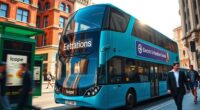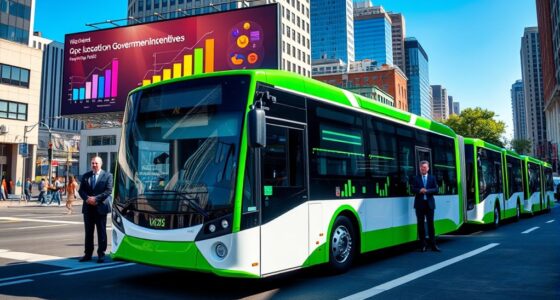Autonomous electric buses are quickly transforming urban transit by offering safer, greener, and more efficient travel options. With advanced tech like Triton cameras and intelligent automation, these buses can navigate city streets reliably in all weather conditions. They reduce emissions, cut noise pollution, and operate around the clock, making cities cleaner and quieter. If you explore further, you’ll discover how these innovations are shaping the future of smarter, more sustainable mobility solutions for everyone.
Key Takeaways
- Autonomous electric buses are increasingly tested and deployed globally, improving urban transit safety and efficiency.
- Advanced automation and battery technologies enhance operational reliability and environmental sustainability.
- Electric buses reduce urban air pollution, noise, and greenhouse gas emissions, supporting sustainability goals.
- Integration with existing infrastructure and safety protocols are ongoing challenges for widespread adoption.
- Continued R&D is driving innovations that promise safer, cleaner, and more efficient urban mobility solutions.

The rise of autonomous electric buses marks a significant shift in urban transportation, combining advanced automation with clean energy solutions. As you observe this transformation, you’ll notice that the technology is increasingly ready for widespread deployment, even though regulatory frameworks are still being developed. Governments and transportation authorities worldwide are working to establish clear rules, but the core systems and innovations behind these buses are already mature enough for real-world implementation.
Pilot programs are actively testing these vehicles across diverse environments, from busy city streets to suburban routes, giving you a glimpse of their potential to reshape daily commutes. Both European and US markets are engaged in testing, indicating a global interest in adopting this sustainable mobility solution.
Global pilot programs showcase autonomous electric buses transforming daily commutes worldwide.
You’ll find that autonomous electric buses are mainly electric, which means they run on clean energy and considerably reduce reliance on fossil fuels. This shift toward electrification not only cuts greenhouse gas emissions but also contributes to better urban air quality. You’ll appreciate how these buses operate quietly, decreasing noise pollution in busy city centers and making your daily environment more comfortable.
To facilitate automation, various models like the Autonomous e-Atak and Alexander Dennis Enviro100AEV are being developed, equipped with sophisticated technology such as Triton cameras and CAVstar systems. These integrations enable the buses to navigate complex traffic situations and respond dynamically to their surroundings, bringing a level of precision and safety that aims to minimize human error. Advanced automation technologies are continuously improving, making these vehicles safer and more reliable over time. Additionally, the integration of electric powertrains ensures that these buses can operate with lower emissions and higher energy efficiency.
It is also important to recognize that the environmental benefits of these buses extend beyond emissions reduction, as they also contribute to decreased urban noise pollution. From your perspective, the benefits are clear: these autonomous electric buses promise safer transit by reducing accidents caused by human mistakes, and they can run continuously, 24/7, regardless of weather conditions. Their efficiency helps improve traffic flow and can lower energy consumption, making urban transit more sustainable.
Additionally, in hazardous conditions like heavy snow or rain, these buses can operate safely, providing reliable transportation when traditional vehicles might struggle. You might also be interested to know that ongoing research and development are focusing on battery technology to further enhance performance and sustainability. The environmental impact is profound, supporting broader sustainability goals by decreasing urban carbon footprints and reducing air and noise pollution. As battery technology advances, the range and charging times of these buses will further improve, enhancing their operational flexibility.
However, implementing autonomous electric buses isn’t without challenges. You’ll need to think about integration with existing traffic systems, establish robust safety protocols, and educate the public on interacting safely with these new vehicles. Ensuring technological reliability and creating legal frameworks are critical steps to guarantee safe and consistent operation.
Real-world examples like Karsan’s Autonomous e-Atak in Europe showcase the promising future of these buses, especially with advanced systems like Triton cameras used in Level-4 autonomous electric buses. As this technology continues to evolve, it has the potential to transform urban mobility into a safer, cleaner, and more efficient experience for everyone.
Frequently Asked Questions
What Are the Safety Measures for Autonomous Electric Buses?
You should know that safety measures for autonomous electric buses include structural protections like protected battery packs and weather-resistant designs, along with automatic disconnects to prevent electrical accidents.
They use sensors, cameras, and continuous monitoring to detect hazards.
Additionally, safety drivers oversee operations, emergency systems are in place, and regular maintenance guarantees everything works smoothly.
Public education and collaboration with emergency responders further enhance overall safety.
How Do Autonomous Buses Handle Unexpected Road Conditions?
You wonder how autonomous buses handle unexpected road conditions. They use a combination of sensors, like cameras, radar, and LiDAR, to detect obstacles or changes in the environment.
AI algorithms process this data instantly, enabling the bus to adjust its speed or route. Continuous updates improve their response strategies, and communication with infrastructure helps navigate complex situations safely.
This integration ensures reliable operation even in unpredictable conditions.
What Is the Cost Comparison Between Autonomous and Traditional Buses?
You might think autonomous buses are just fancy robots, but they actually cost more upfront due to tech and electric systems.
Yet, you save big on drivers and maintenance, making the total cost lower over time.
Imagine paying more at first, only to enjoy cheaper rides and safer travels later.
The irony? That initial investment can lead to long-term savings and a cleaner, more accessible public transit system.
How Do Passengers Interact With Autonomous Bus Systems?
You interact with autonomous bus systems mainly through digital displays and sensory feedback. These displays inform you about the route, safety features, and journey updates.
You might also use accessibility features like ramps or audio messages for convenience. The system’s real-time information and safety measures, like safety drivers, help you feel secure and engaged.
This makes your ride smooth and accessible while building trust in the autonomous technology.
What Is the Environmental Impact of Widespread Autonomous Electric Bus Adoption?
You might think widespread autonomous electric buses are just about saving the environment, but they do come with complexities. They can markedly cut emissions and improve air quality, especially if powered by renewable energy. However, manufacturing impacts, material extraction, and potential grid strain can offset some benefits.
Still, with smart planning and tech, you could enjoy cleaner air and more efficient transit while reducing your carbon footprint—irony included.
Conclusion
As autonomous electric buses take the wheel, they’re transforming transportation into a well-oiled machine of innovation. Imagine this shift as a tide lifting all boats, propelling cities toward cleaner, smarter futures. With each new route, you’re witnessing a revolution on wheels—quiet, efficient, and sustainable. Embrace this wave of change, because the journey to smarter cities is just beginning, and you’re right at the forefront, steering toward a brighter horizon.









